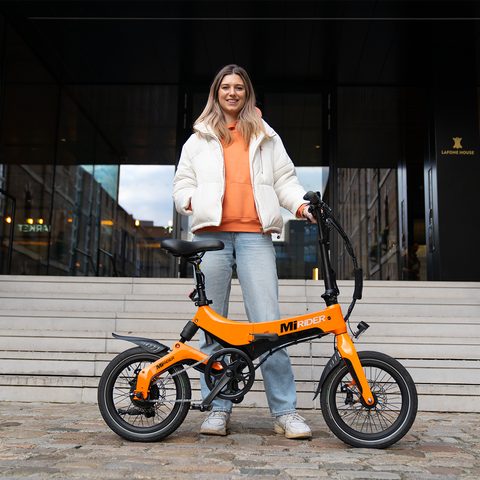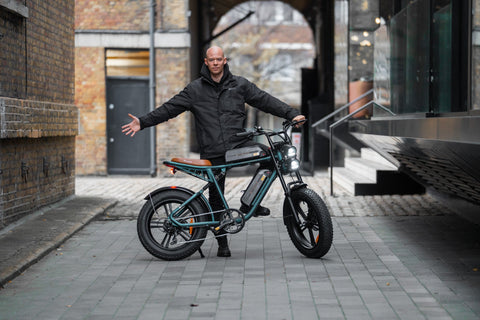Overall rating:
The Beameo Ray, £1,429.99, is a hybrid electric bike with an old-school cruiser vibe, unashamedly simple in its aim and execution, but in a lot of ways all the better for it. It’s got bags of retro charm, a solid choice of components and is easy and comfortable to ride.
With practicalities like mudguards, light, kickstand and rear rack all included, and a big battery with up to 75 miles of power assistance, it SHOULD be as at home on an urban commute as on a scenic countryside cycle path. We put it through its paces to find out if it’s as good in the real world as it is on paper.

Good for
- Old-school cool
- City commuting
- Cyclepath cruises
Pros
- Retro looks
- Comfortable ride
- Included lights, mudguard, rack and kickstand
- Strong battery range
Cons
- Heavy
- Battery integration isn’t exactly subtle
- Only one colour choice
- Not particularly nimble

Expert Verdict
The Beameo Ray is a charming, retro and straightforward e-bike that doesn’t try to reinvent the wheel (or any other component), and that approach made it a joy to ride.
It uses solid, proven tech and I found it to be comfortable and practical, with plenty of battery power and a strong motor. At around £1,400 it represents decent value for money, and should be straightforward and affordable to maintain, repair and upgrade over time.
It’s no lightweight, and I wish there were a few more colour options (blue is your only choice), but overall this is an e-bike I can thoroughly recommend.
| Sizing | One size, suitable for adults between 170cm/5’6” and 195cm/6’4” |
| Max Rider Weight | 120kg |
| Frame Material | Aluminium |
| Wheel Size | 700C, Kenda 45c tyres |
| Weight | 28kg |
| Gears | Seven-speed Shimano Tourney |
| Brakes | Tektro mechanical disc brakes front & rear |
| Weight | 16.5kg |
| Assembled & built | Wales, United Kingdom |
| Range | Up to 120km/75 miles |
| Motor | 48V, 250-Watt rear-wheel hub |
| Battery | 12.8Ah 48V |
| Charging | 6-7 hours. Charger included |
| Speed | 15.5mph (UK e-bike speed limit) |
| Power Modes | Five power assist modes |
| Display | KeyDisp LCD display |
| Lights | Front included |
| Mudguards | Included |
| Rear Rack | Included |
Ratings
| Overall | |
| Components and build quality | |
| Safety and security | |
| Performance and handling | |
| Comfort and practicality |
Components and build quality
The Beameo Ray is at the lower end of the e-bike market, so the components used in its build are nothing special, but they’ve been well chosen to fit the budget without overly compromising comfort or performance.
The Ray’s main selling point is its quirky frame design, reminiscent of the Schwinn cruiser bikes of the 1970s and ‘80s, which at the time of riding you can order in any colour so long as it’s aquamariney blue. Onto its aluminium is mounted a hulking great 614Wh battery, powering a 250W motor on the rear hub.

The swept-back handlebars have leather grips and a Shimano seven-speed thumb shifter mounted on the right bar, operating a Shimano Tourney derailleur at the back. In an age of integrated batteries, belt drives and all manner of modern innovations, I found it refreshingly old-fashioned, even though the Beameo brand only launched in 2023. The Tektro mechanical brakes are operated by Promax levers and there’s an LCD display on the left handlebar.
The Ray uses a cadence sensor, which monitors how fast you’re spinning the pedals and deploys power assistance accordingly. As with most cadence sensors, I found it takes a second or so to register the fact that I was spinning the pedals. But after that I had plenty of oomph behind me, and the amount of electric grunt and the spread of gears meant I found it easy to get moving, even when pushing away from standstill on hills.
The crank is made by Prowheel and the pedals are VP mountain-bike units that felt nicely wide and grippy under my feet.

A squishy but supportive Selle Royal saddle was fitted to our test bike, and mounted to the 700c wheels are 45c Kenda tyres. Beameo has also thrown in front and rear mudguards and a front light LED light (but only a reflector on the rear). A rack’s included too, as is a kickstand. There are far more expensive bikes that don’t feature these accessories as standard, so it’s great to see them included here.
Build quality feels excellent – even after many hours of riding put into our test unit, I didn’t notice any creaks, squeaks or rattles.
Safety and security
![]()
Eschewing the trend for integrating batteries into the frame or seatpost, the Beameo Ray’s battery is conspicuously bolted straight on the downtube, and secured with a key to on the left-hand side. That means it’s tricky to whip off for opportunists, but you can easily remove it for security or for charging in a flat or office. Unlike some e-bikes, however, ne’er-do-wells could ride the Ray as a normal bike, sans battery, so we’d strongly recommend investing in at least a stout D-lock to keep the bike secure when it’s parked up.

The Tektro mechanical disc brakes work well. Sure, I didn’t get the feel and degree of modulation that you’d get from hydraulic brakes, but such units would drive up the price. However, they’d be a relatively easy upgrade if you wanted them.
I found that the mechanical setup, with comfortable Promax brake levers, gave me much better stopping power than calliper brakes would, and despite the Ray’s considerable weight I had no problem shaving off speed for traffic lights or slamming on the anchors for van drivers pulling out without looking.
An LED powered front light is included, attached to the steerer tube just above the front wheel, and turned on and off by holding the + button on the LCD display. There’s no rear light however, just a reflector, so you may want to add your own.

Performance and handling
The Beameo Ray’s approach to power is simple, but it’s very effective. The big battery gives you a big range, and the motor deploys all the power you need up to 15.5mph, which is the maximum assisted speed allowed under UK law.
I had five levels of assist to choose from, and when combined with the well-proven Shimano gears, I found it had all the flexibility I needed and more on my test route. While I didn’t get the chance to try it on properly steep hills, I strongly suspect it would need a fairly serious wall to cause any major issues – with the lowest gear and maximum assist, the Ray should tackle some pretty substantial slopes.
The size of the battery means you should get a fairly long ride out of a single charge, especially if you’re canny about how often you deploy max power. I found that on our predominantly flat test route that I never really needed more than level three, with the top levels reserved for hills (or fun). Beameo quotes a slightly vague range of between 18 and 74 miles on a full battery charge, but that suggests it’ll easily soak up even lengthy commutes.
Using the thumb gear-shifter on the right handlebar is quick and satisfying, and I could control the power assistance using buttons on the simple but easy-to-read LCD display on the left handlebar. That same display also shows speed, battery life and a trip meter.

Power assistance, then, is well taken care of, and the handling is decent too. I found it a very easy bike to spend a long time on, and while it’s not the nimblest of machines, due in part to its substantial 28kg weight, it’s composed and predictable enough to be able to weave through traffic or ride down tight alleyways. At higher speeds I was stable and confident, and the spread of gears meant it was easy to sit at a comfortable pedal cadence at the max assisted speed.
Comfort and practicality
As a cruiser bike, the Ray favours comfort over speed and agility, and I found the upright, relaxed position and swept-back handlebars brilliant for swanning along London’s cycleways. Saddles are always a personal choice but the Selle Royal unit on our test bike provided lots of cushioning even when the roads get bumpy, aided by the chunky, wide Kenda tyres.
Practicality levels are good, too. Front and rear mudguards are included, as is a rack for carrying bags or attaching panniers. A chain guard will help prevent oil getting on your clothes.

What’s more, because the Ray uses so many “traditional” parts, rather than fancy, custom components, maintenance and repair should be very easy – just about every component is easily replaceable from your local bike shop or online.
It’s worth mentioning again that, at 28kg, the Ray is a heavy bike, and bulkier than a lot of other e-bikes. If you need to take your ride upstairs at the end of the day, it might not be the best option. But if that’s not a worry then it doesn’t negatively affect the riding experience.
See our review of the Beameo Unbound and our Beameo Classic review.
Bio
Phill Tromans has been a journalist and reviewer since 2001. As both a keen road cyclist and car aficionado, he’s fully embraced the concept of e-mobility, and while he still loves pure pedal power, he also likes not being a sweaty mess at the end of every bike ride.




